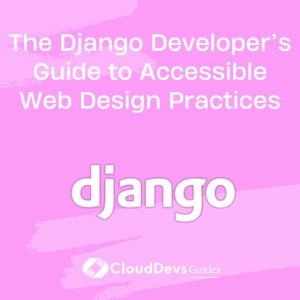The Django Developer’s Guide to Accessible Web Design Practices
In the digital age, web accessibility has become a pivotal aspect of user interface design. It ensures that websites and applications are accessible to all users, including those with disabilities. Django, a high-level Python web framework, encourages rapid development and clean, pragmatic design. This blog post explores the intersection of Django and web accessibility, providing insights into designing accessible user interfaces. You can hire Django Developers for your projects to ensure greater success.
Table of Contents
1. Understanding Web Accessibility
Web accessibility refers to the inclusive practice of ensuring there are no barriers that prevent interaction with, or access to, websites by people with disabilities. When sites are correctly designed, developed, and edited, all users have equal access to information and functionality. Read more: https://www.w3.org/WAI/
2. Django’s Role in Accessibility
Django, being a versatile framework, offers various tools and features that support accessible web development. For instance, Django’s template system encourages separation of content and presentation, which is a cornerstone of accessible web design. More on Django’s features can be found on the official Django Project website ([external link to Django Project]).
3. Design Principles for Accessible Interfaces
– 1. Semantic HTML:
Using semantic HTML elements ensures that the structure of the web page is meaningful. Django templates can be crafted with semantic HTML to improve accessibility.
– 2. ARIA (Accessible Rich Internet Applications) Attributes:
ARIA attributes provide additional context to assistive technologies.
Read more: https://www.w3.org/TR/wai-aria/
– 3. Keyboard Navigation:
Ensuring that all interactive elements are accessible via keyboard is crucial. Django forms and widgets can be customized to enhance keyboard navigation.
4. Testing for Accessibility
Testing is a critical part of designing accessible interfaces. Automated tools like Axe or Lighthouse can be integrated into the development process. Additionally, manual testing by users with disabilities offers invaluable insights. The WebAIM (Web Accessibility In Mind) website ([external link to WebAIM]) provides excellent resources on accessibility testing.
5. Examples of Accessible Design in Django
– Case Study 1: Accessible Forms:
Discuss how Django forms can be made accessible by using labeled form fields, error identification, and proper form validation.
– Case Study 2: Navigation and Structure:
Explore how Django templates can be used to create a coherent structure that is navigable by screen readers.
– Case Study 3: Interactive Elements:
Illustrate the use of ARIA roles and properties in Django to make dynamic content accessible.
6. Legal and Ethical Considerations
Understanding the legal landscape, like the Americans with Disabilities Act (ADA), and ethical considerations is important for developers.
Read more: https://www.djangoproject.com/
Conclusion
Designing accessible user interfaces with Django not only broadens your audience but also aligns with ethical web development practices. By adhering to accessibility guidelines and leveraging Django’s features, developers can create inclusive and effective web experiences for all users.
You can check out our other blog posts to learn more about Django. We bring you a complete guide titled Django and Accessibility: Building Inclusive Web Applications along with the Django and Scalability: Building Web Apps for High Traffic and Django Templates: Creating Dynamic and Responsive Web Pages which will help you understand and gain more insight into the Django programming language.
Table of Contents







